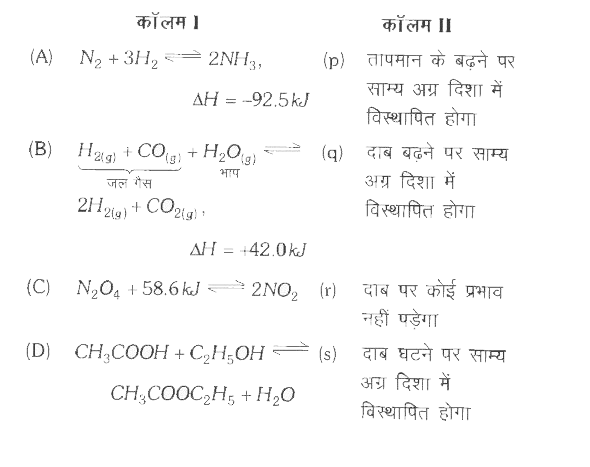प्रकथन: अभिक्रिया के लिए, की इकाई वायुमंडल होगी|
कारण: की इकाई (वायुमंडल) है|
प्रक्कथन और कारण दोनों सही हैं और कारण प्रक्कथन का सही स्पष्टीकरण देता है
प्रक्कथन और कारण दोनों सही हैं किन्तु कारण प्रक्कथन का सही स्पष्टीकरण नहीं देता है
प्रक्कथन सही है किन्तु कारण गलत है
प्रक्कथन गलत है किन्तु कारण सही है
The correct Answer is:D
दी गई अभिक्रिया के लिए की इकाई है|
Topper's Solved these Questions
- BOOK - ERRORLESS HINDICHAPTER - रासायनिक साम्य EXERCISE - JEE ADVANCED (MATRIX MATCH TYPE QUESTIONS)1videos
रासायनिक साम्य
- BOOK - ERRORLESS HINDICHAPTER - रासायनिक विश्लेषणEXERCISE - Assertion & Reason16videos
रासायनिक विश्लेषण
- BOOK - ERRORLESS HINDICHAPTER - रेडॉक्स अभिक्रियाएँ EXERCISE - Assertion & Reason9videos
रेडॉक्स अभिक्रियाएँ
Similar Questions
इस खण्ड में कुछ प्रश्न है। प्रत्येक प्रश्न में कॉलम-1 में कुछ कथन (A, B, C और D) और कॉलम-II में कुछ कथन (p, q, r, s और t) है। कॉलम-1 का कोई भी कथन कॉलम-II के एक कथन या एक से अधिक कथनों से मेल खाता है। उदाहरण के लिए, दिए हुए प्रश्न में यदि कथन B कथनों और r से मेल खाता है, तो ORS में उस प्रश्न के लिये कथन B के सामने और से संबंधित बुलबुलों को काला कीजिए।
कॉलम । में दी गई प्रविष्टियों को कॉलम II में दी गई प्रविष्टियों से सुमेलित कीजिए।
 01:32View Solution
01:32View Solutionनिम्नलिखित प्रश्नों में प्रक्कथन (Assertion) के वक्तव्य के पश्चात् कारण (Reason) का वक्तव्य है।
प्रक्कथन : चूने का पानी CO2 प्रवाहित करने पर धुंधला हो जाता है किन्तु अधिक CO2 प्रवाहित करने पर साफ हो जाता है।
कारण : चूने का पानी कैल्शियम हाइड्रॉक्साइड, Ca(OH)2 होता है।03:57View Solutionप्रक्कथन : SO2 एवं Cl2 दोनों ही विरंजक हैं।
कारण : दोनों अपचायक हैं।02:17View SolutionKp and Kc are inter related as
Kp=Kc(RT)Δn
Answer the following questions:
For N2(g)+3H2(g)⇔2NH3(g),Kp/Kc is equal to:01:33View SolutionThe relation between K_(p) and K_(c) is K_(p)=K_(c)(RT)^(Deltan) unit of K_(p)=(atm)^(Deltan) , unit of K_(c)=(mol L^(-1))^(Deltan) Consider the following reactions: i. CO(g)+H_(2)O(g) hArr CO_(2)(g)+H_(2)(g), K_(1) ii. CH_(4)(g)+H_(2)O(g) hArr CO(g)+3H_(2)(g), K_(2) iii. CH_(4)(g)+2H_(2)O(g) hArr CO_(2)(g)+4H_(2)(g), K_(3) Which of the following is correct?
02:38View SolutionThe relation between Kp and Kc is Kp=Kc(RT)Δn unit of Kp=(atm)Δn, unit of Kc=(molL−1)Δn
Given: 2NO(g)+O2(g)⇔2NO2(g),K1
2NO2(g)⇔N2O4(g),K2
2NO(g)+O2(g)⇔N2O4(g),K3
Which of the following relations is correct?01:19View SolutionFor the reaction, N_(2)(g)+3H_(2)(g) hArr 2NH_(3)(g) , the units of K_(p) are …………
03:01View SolutionFor the reaction
2NH3(g)⇔N2(g)+3H2(g) the units of Kp will be02:11View SolutionAssertion: For the 2NH_(3(g))hArr N_(2(g))+3H_(2(g)), the unit of K_(p) will be at. Reason: Unit of K_(p) is (atm)^(Deltan),
03:37View Solutionअभिक्रिया N2(g)+3H2(g)⇔2NH3(g) के लिए Kp=Kc(RT) ............
02:47View Solution(K_(c))/(K_(p)) for the reaction, N_(2)(g)+3H_(2)(g)hArr2NH_(3(g)) is
04:16View SolutionFor N2(g)+3H2(g)⇔2NH3(g), show that Kc=Kp(RT)2.
03:09View SolutionFor the equilibrium N_(2(g))+3H_(2(g))hArr2NH_(3(g)) Write K_(P) and K_(C) relationship.
04:22View SolutionK_(p) and K_(p)^(**) are the equilibrium constants of the two reactions, given below (1)/(2)N_(2)(g)+(3)/(2)H_(2)(g)hArr NH_(3)(g) N_(2)(g)+3H_(2)(g)hArr 2NH_(3)(g) Therefore, K_(p) and K_(p)^(**) are related by
03:19View SolutionK_(p) and K'_(p) are equilibrium constants of the two reactions given below : (1)/(2)N_(2)(g)+(3)/(2)H_(2)(g) hArr NH_(3)(g) N_(2)(g)+3H_(2)(g)hArr 2NH_(3)(g) Therefore K_(p) and K'_(p) are related by :
04:43View Solutionनीचे दी गई दो अभिक्रियाओं के साम्य स्थिरांक क्रमशः Kp तथा Kp' हैं:
12N2(g)+32H2(g)→NH3(g)
N2(g)+3H2(g)→2NH3(g)
अतः Kp or Kp' सम्बन्धित होंगे01:31View Solution

